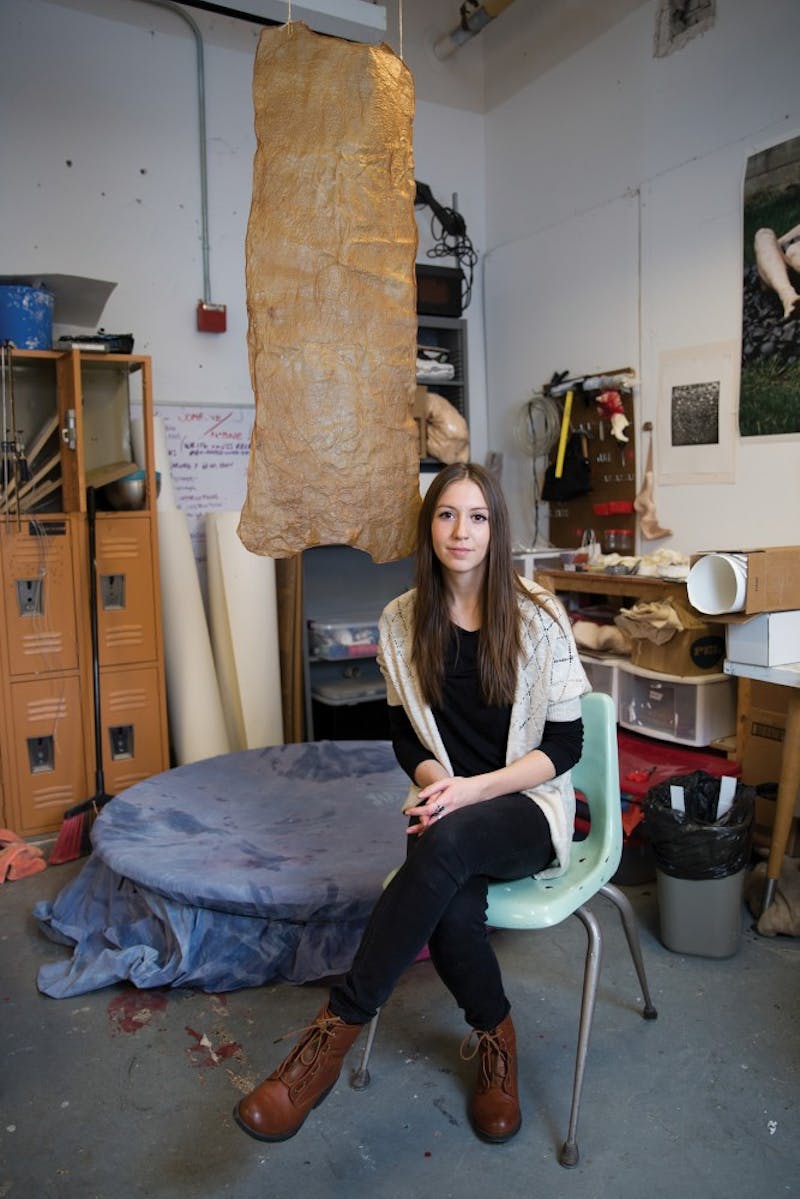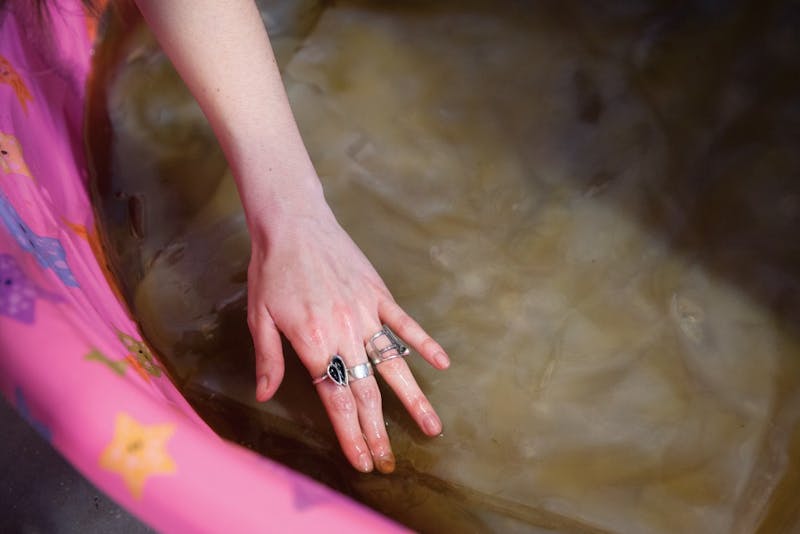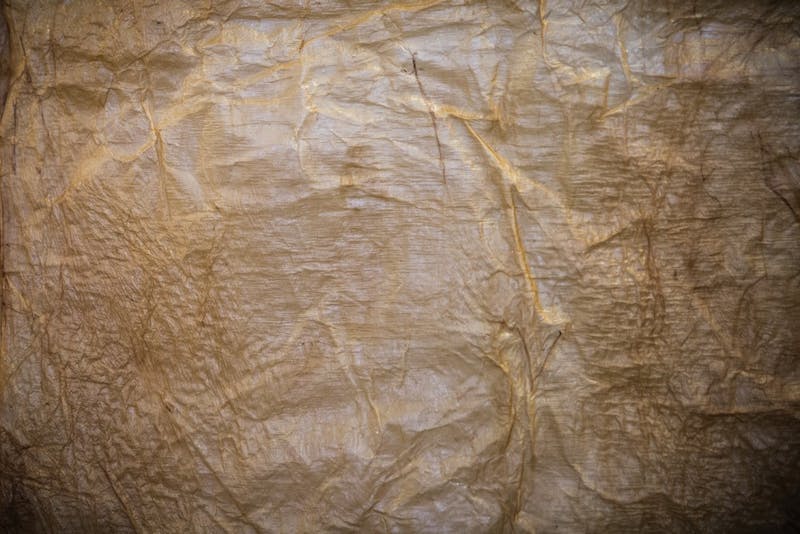

REBEKAH BARNES / SENIOR WRITER
Lindsay Koontz started growing kombucha “mothers” — or scobys, a symbiotic culture of bacteria and yeast — in a jar. Now, she’s growing them in kiddie pools.
It has become her child. She has to make sure the room she keeps it in is the right temperature and it has enough space to grow. She checks in on it daily as it feeds off a tea that it lays on.
When the kombucha is ready, she washes it and lays it out to dry, covers herself in it and then either photographs herself or has someone else take her photo. The kombucha at that point has transformed into an almost-translucent skin, shielding her from what can hurt her. The photos are printed in breast milk.
Koontz, a third-year MFA candidate studying sculpture + expanded practice, works with materials such as kombucha, breast milk, gelatin and animal fat in order to give meaning to her work.
Koontz’s thesis is centered around the concept of “the mother.” From there, she gets her ideas of creating shields from kombucha mothers and creating prints with breast milk.
“There’s definitely a connection between all of those things that I don’t think was happenstance,” Koontz said.
Her relationship with her mother also inspires her work.
“She is why I do what I do,” Koontz said.
Koontz is originally from Youngstown and completed her bachelor’s degree in sculpture at Kent State University. At OU, she teaches an image foundation class and has a minor in psychology, which she credits to her introspective and observational nature in her art.

She said her thesis has been a goal she’s been working toward during her entire education.
“(Working on these projects) definitely taught me a lot about myself and how I cope within certain situations,” Koontz said. “That’s the whole purpose of the thesis is to basically be a witness of someone who is attempting to heal themselves.”
An ability to adapt is necessary when using unconventional materials. For instance, animal fat melts and gelatin can rot. She had to figure out ways to mix animal fat and gelatin with separate materials, such as glycerin, so it can withstand handling and time in a gallery.
“I think the thing that is the most challenging about my work is that everything is ephemeral,” Koontz said. “The biggest challenge is always changing my medium and learning how to adjust to that.”
Her work with animal fat turned into creating tiny shields that people would hold up and use to guard parts of themselves they wanted to protect. From there, she felt like her message was leaning too closely to a statement on animal rights.
To move away from that, she switched gears and looked into breast milk as a human fat.
Her partner, Josh Raftery, who is a photography instructor at the University of Kentucky, prints images with blood. After trial and error, she found she could do the same printing with breast milk. The printing uses a gum bichromate process, which uses different chemicals and the breast milk to create an image through dark room development. She only needs about 16 grams of breast milk to produce six images.
She was able to put out a call to action on onlythebreast.com, where women can sell their breast milk and others can buy it. It is typically used between mothers who have excess milk and those who can’t produce. Koontz didn’t want to take advantage of that process, and she started blogging and reaching out to mothers about her work.
In her most recent adventures with art experimentation, she uses kombucha. Her eyes light up as she describes the journey that she has gone with her kombucha — and discovering that she has in turn become the mother of it. As the piece continues to enlarge, she at one point wondered what would happen if she set it in Dow Lake at Strouds Run State Park.
As to not negatively affect the environment around her, she said she’s considering writing a grant proposal for a pool to put it in.
“You are so dedicated to your medium,” Koontz said. “You treat your work like it’s your baby. … I felt such a connection with this medium because it’s the first thing that I’ve used that’s actually alive. It reminds me of the phenomenon that basically having to take care of another life gives you purpose. I’m not saying it’s to that extent, but I won’t say that I don’t feel responsible for this thing. It’s like more than a plant for me. You don’t bathe your plant.”

If the kombucha rips, it grows back. When it’s growing in the tea, its slimy-yet-smooth feeling is back by an almost-muscular makeup. It’s that mixture between the tough and the sensitive that creates the message she’s looking for.
Her photographic series will be printed in the breast milk using the gum bichromate process. Some other pieces of dried kombucha will hang during her thesis gallery as well.
Koontz’s art, and artists’ work in general, has a common theme: Everything is thoroughly researched.
“We all know that art takes a lot of time,” Koontz said. “But … you have to back all of your work with research. Whether that be theory or philosophy or biology or psychology — I feel like it’s equally as important to be a good writer and a good marketer … as it is to producing good work.”
With her drive to create and find new media, innovating in her field doesn’t look it’s going to stop anytime soon.
“Innovation to me is finding different ways to utilize the material that seems like it can’t be the thing that you would use,” Koontz said. “So, if I had an idea that I need something that’s associated with breast milk and the maternal ... I become innovative by using that thing and then working toward learning how to manipulate the material in the correct way.”
Photos by : Liz Moughon / Photo Editor
Developed by: Seth Archer / Digital Managing Editor